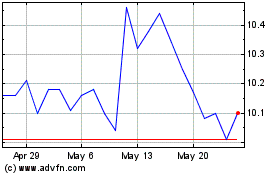N.Y. Fed Adds Wells Fargo as a Primary Dealer
April 18 2016 - 6:10PM
Dow Jones News
Wells Fargo Securities LLC joined the elite club of primary
dealer banks for the U.S. government bond market on Monday.
The news was released by the Federal Reserve Bank of New
York.
Wells Fargo becomes the 23rd primary dealer, which trades
directly with the N.Y. Fed and is obligated to underwrite U.S.
government debt sales.
It was the first time the N.Y. Fed added a new member to the
club since Feb 2014 when TD Securities (USA) LLC was named a
primary dealer.
Analysts say a larger pool of dealers will benefit the Federal
Reserve as it needs counterparties to mop up excess liquidity
pumped into the banking system since the 2008 financial crisis. The
Fed ended its bond buying program in 2014 and raised short-term
interest rates in December for the first time since 2006. Fed
officials have signaled a slow path of normalizing interest rate
policy amid uncertain global growth outlook.
Being a primary dealer carries perks for banks too.
A spokesman at the NY Fed declined to comment.
Though the firms have to meet certain standards, they benefit by
being able to attract more business in the Treasury market. It also
raises the firm's profile, which in turn could boost business in
trading and dealing in the broader credit markets.
As counterparties to the Fed, they meet with Fed policy makers
as well as Treasury officials regularly to discuss funding needs,
auction schedule changes and the interest-rate outlook.
"Primary Dealership will allow us to better serve our existing
customer franchise and is a logical extension of our client-focused
business model," said Walter Dolhare, head of Wells Fargo
Securities' Markets Division.
Still, traders say the allure of being a primary dealer has been
dimmer compared with the era before the crisis.
Tighter banking regulations have pushed big dealer banks to pull
back on fixed income trading. Facing stricter capital requirements
to beef up their balance sheet, they become more hesitant to
connect buyers with sellers in the bond market.
In addition, primary dealers are competing with a wider pool of
investors, especially as hedge funds and high frequency trading
firms have entered into Treasury bond markets.
The structural changes in the bond market have raised concerns
over liquidity.
Regulations and investors are still struggling to pinpoint the
exact reason causing the " flash crash" in Oct. 2014 for the yield
on the benchmark 10-year Treasury note. The yield tumbled and then
quickly reversed in short order and many said thinner liquidity
magnified the violent swings.
Write to Min Zeng at min.zeng@wsj.com
(END) Dow Jones Newswires
April 18, 2016 17:55 ET (21:55 GMT)
Copyright (c) 2016 Dow Jones & Company, Inc.
Pacific Current (ASX:PAC)
Historical Stock Chart
From Jan 2025 to Feb 2025

Pacific Current (ASX:PAC)
Historical Stock Chart
From Feb 2024 to Feb 2025
